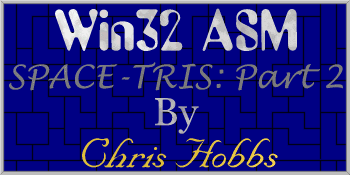11/10 - 11/12 @ Montréal, Canada
12/5 - 12/7 @ Shanghai, China
12/24 - 12/27
2/28 - 3/4 @ San Francisco, CA
More events...
2406 articles in the reference section.
Help us fight cancer!
Join SETI Team GDNet!

|
Connecting to Direct DrawNow we are going to get a little bit advanced. But, only for this section. Unfortunately there is no cut and dry way to view DirectX in assembly. So, I am going to explain it briefly, show you how to use it, and then forget about it. This is not that imperative to know about, but it helps if you at least understand the concepts. The very first thing you need to understand is the concept of a Virtual Function Table. This is where your call really goes to be blunt about it. The call offsets into this table, and from it selects the proper function address to jump to. What this means to you is your call to a function is actually a call to a simple look-up table that is already generated. in this way, DirectX or any other type library such as DirectX can change functions in a library w/o you ever having to know about it. Once we have gotten that straight we can figure out how to make calls in DirectX. Have you guessed how yet? The answer is we need to mimic the table in some way so that our call is offset into the virtual table at the proper address. We start by simply having a base address that gets called, which is a given in DirectX libraries. Then we make a list of all functions for that object appending the size of their parameters. This is our offset into the table. Now, we are all set to call the functions. Calling these functions can be a bit of work. First you have to specify the address of the object that you want to make the call on. Then, you have to resolve the virtual address, and then, finally, push all of the parameters onto the stack, including the object, for the call. Ugly isn't it? For that reason there is a set of macros provided that will allow you to make calls for these objects fairly easily. I will only cover one since the rest are based on the same premise. The most basic one is DD4INVOKE. This macro is for a Direct Draw 4 object. It is important that we have different invokes for different versions of the same object. If we did not, then wrong routines would be called since the Virtual Table changes as they add/remove functions from the lib's. The idea behind the macro is fairly simple. First, you specify the function name, then the object name, and then the parameters. Here is an example:
The above line of code calls the CreateSurface() function on a Direct Draw 4 object. It passes the pointer to the object, the address of a Direct Draw Surface Describe structure, the address of the variable to hold the pointer to the surface, and finally NULL. This call is an example of how we will interface to DirectX in this article series. Now that we have seen how to make calls to DirectX, we need to build a small library for us to use which we cover in the next section. |
|
|
|
|